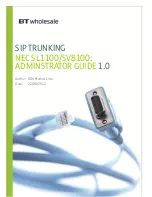
–
The forwarding destination is an outside party, including an extension at another PBX in the network.
–
FWD to trunk is allowed through COS programming for the virtual PSs.
•
Up to 4 virtual PSs can be assigned to a single ICD Group. If more than 4 are assigned, the 4 virtual PSs
with the lowest member numbers are available.
•
This feature for LCOT depends on the settings for reverse signal detection. (
®
•
Calls to an ICD Group will ring at a virtual PS even if all of the other extensions assigned to the group are
busy.
•
If all members of an ICD Group are virtual PSs, and trunk lines are available but the called parties are all
busy, neither the queuing or overflow features will operate. Therefore, it is recommended that at least one
PT or SLT is also assigned to an ICD Group.
•
To log in to or out of a group, a virtual PS user can access the PBX through DISA, enter the Walking COS
feature number (if required), and access log-in/log-out settings.
•
Delayed ringing can be assigned for virtual PSs in the same way as for other extensions.
•
The Wrap-up time feature and Automatic Log-out feature are not available for virtual PSs.
•
When forwarding calls to a public trunk, system programming selects whether the CLIP number of the
calling party or of the virtual PS is sent to the forward destination.
When calling using a private network, the CLIP number of the calling party will always be sent.
•
DSS button for Cellular Phone XDP Parallel
The DSS button light of the extension registered first in an ICD Group will turn red if the parallel cellular
phone:
–
is on a trunk call that was received via the ICD Group.
–
is on a trunk call that was made using the Walking COS Through DISA feature. (
®
PC Programming Manual References
10.9 PBX Configuration—[2-9] System—System Options—Option 4
Send CLIP of CO Caller—when call is forwarded to CO
Send CLIP of Extension Caller—when call is forwarded to CO
12.1.1 PBX Configuration—[4-1-1] Extension—Wired Extension—Extension Settings—Option 9—
Feature Guide References
5.2.4.6 Virtual PS
4.3.6 Network ICD Group
Feature Guide
59
2.2.2 Incoming Call Distribution Group Features
Summary of Contents for KX-NS500
Page 14: ...14 Feature Guide Table of Contents...
Page 15: ...Section 1 For Your Safety Feature Guide 15...
Page 18: ...18 Feature Guide 1 1 1 For Your Safety...
Page 19: ...Section 2 Call Handling Features Feature Guide 19...
Page 57: ...632 Maximum Number of Agents Feature Guide 57 2 2 2 Incoming Call Distribution Group Features...
Page 107: ...User Manual References 1 2 1 Basic Calling Feature Guide 107 2 5 4 Trunk Call Features...
Page 193: ...User Manual References 1 4 2 Holding a Call Feature Guide 193 2 13 1 Call Hold...
Page 324: ...324 Feature Guide 2 30 2 Outgoing Message OGM...
Page 325: ...Section 3 Unified Messaging System Feature Guide 325...
Page 375: ...Section 4 Network Features Feature Guide 375...
Page 464: ...464 Feature Guide 4 3 6 Network ICD Group...
Page 465: ...Section 5 System Configuration and Administration Features Feature Guide 465...
Page 560: ...560 Feature Guide 5 6 7 PING Confirmation...
Page 561: ...Section 6 Appendix Feature Guide 561...
Page 578: ...578 Feature Guide 6 5 2 PFMPR Software File Version 004 2xxxx...
Page 579: ...Feature Guide 579 Notes...











































